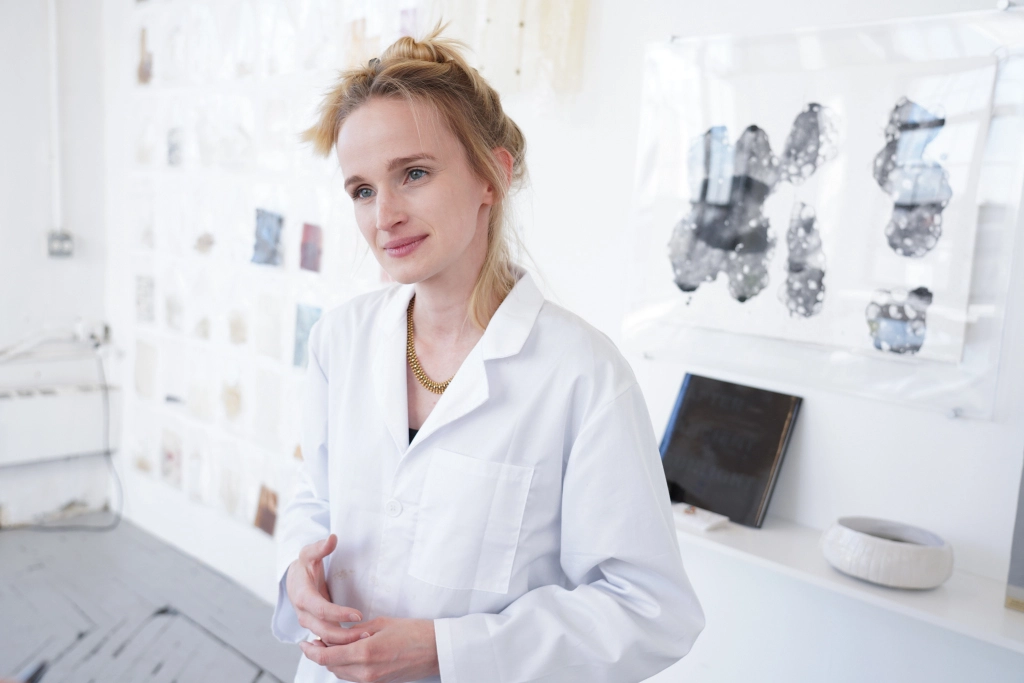When one thinks of algae, images of slimy substances in lakes or oceans may come to mind. However, Assistant Professor Charlotte McCurdy from Arizona State University (ASU) is transforming the perception of algae by harnessing its potential to revolutionize sustainable fashion. Using algae, she has created innovative materials for raincoats, sequins, and even backpacks, with a vision to decarbonize the textile industry and reduce our reliance on fossil fuels.
Redesigning Fashion for Sustainability
As an assistant professor in The Design School at ASU, Charlotte McCurdy is driven by a passion to explore ways to decarbonize not only energy and fuels but also the fashion industry. Currently, more than half of the textiles used globally are derived from fossil fuels, contributing to environmental pollution and carbon emissions. McCurdy’s goal is to reimagine fashion by utilizing sustainable, algae-based materials to minimize the industry’s carbon footprint.
From Experiments to Prototypes: The Algae Raincoat Journey
To create her algae-based raincoat, Charlotte McCurdy embarked on a journey of rigorous experimentation and research. The process involved numerous trials and tests to develop a clear material suitable for producing sustainable jackets. The design phase alone took about six months, followed by an additional six months of lab-based experiments.
During these extensive trials, McCurdy explored various formulations and techniques to perfect the algae-based material. She demonstrated remarkable tenacity in her pursuit of creating a sustainable raincoat that aligned with her vision of reducing fashion’s impact on the environment.
The Path to Sustainable Fashion
By utilizing algae as the foundation for fashion materials, Charlotte McCurdy has taken a giant leap toward sustainability. Algae are a renewable resource that can be cultivated with minimal environmental impact, making them an ideal alternative to petroleum-based textiles.
Beyond raincoats, McCurdy has extended her experimentation to create algae-based sequins and backpacks, showcasing the versatility and potential of these eco-friendly materials in diverse fashion applications.
A Sustainable Future in Fashion
Charlotte McCurdy’s groundbreaking work exemplifies the power of innovative thinking and interdisciplinary collaboration in transforming industries for the better. By introducing algae-based materials into fashion, she is paving the way for a more sustainable and eco-conscious future, where clothing can be both stylish and environmentally responsible.
Her research not only challenges the status quo of the fashion industry but also serves as an inspiration to designers, scientists, and entrepreneurs to explore sustainable solutions in their respective fields.
Conclusion: Fashioning Change for a Greener World
Charlotte McCurdy’s pioneering efforts in using algae to create sustainable fashion materials represent a paradigm shift in the industry. Her commitment to decarbonizing textiles and reducing our reliance on fossil fuels showcases the potential for innovation to drive positive change.
As the world becomes increasingly conscious of the environmental impact of various industries, McCurdy’s work serves as a beacon of hope and progress, showing that creative thinking and sustainable practices can coexist to build a greener and more sustainable future for generations to come.













Thanks for finally writing about > Charlotte McCurdy: Pioneering
Sustainable Fashion With Algae-Based Materials – Womenpreneur < Liked it!
It’s truly a great and helpful piece of info.
I am happy that you simply shared this useful information with us.
Please keep us informed like this. Thank you for sharing.
What’s up, its nice post about media print, we all understand media is a
wonderful source of information.
I am really thankful to the owner of this site who has shared this impressive paragraph at at this place.
whoah this blog is magnificent i like reading your articles.
Stay up the great work! You know, lots of people are looking round for this information, you can help them greatly.
My partner and I stumbled over here different web address and thought
I might check things out. I like what I see
so now i’m following you. Look forward to going over your web page for a second
time.
Hi, i think that i saw you visited my site thus i came to “return the favor”.I
am trying to find things to enhance my website!I suppose its ok to use
some of your ideas!!